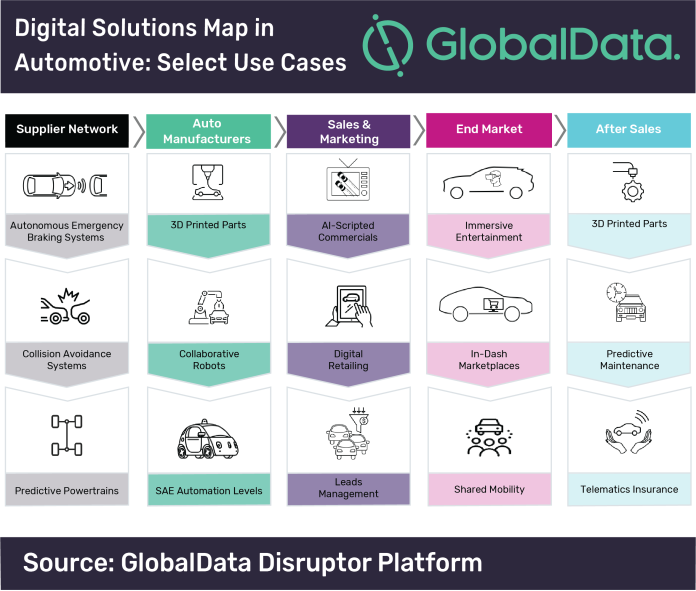
From automation and seamless connectivity to personalization, digital technologies are putting the automotive industry in a state of disruptive transition. Against this backdrop, auto manufacturers need to explore new digital solutions across the value chain to conceive new models and survive in the rapidly transforming industry.
Kiran Raj, Disruptive Tech Analyst at GlobalData, comments: “The pace at which the automotive industry has adopted new technologies accelerated remarkably over the last five years. Vehicles are no longer the only focus but building innovative models around the hyper-demanding consumers is.”
The Digital Solutions Map in Automotive of GlobalData’s Disruptor database unveils over 70 innovative use cases of digital technologies across the automotive value chain:
Collision Avoidance Systems
As the automotive industry is pushing towards the distant future of fully autonomous cars, the demand for advanced driver assistance systems (ADAS) is growing. Intel’s ADAS developer Mobileye recently launched an AI-powered collision avoidance system, which can warn vehicle drivers with both visual and audio alerts in real-time to avoid collisions. What sets apart the system’s design is the use of deep neural networks (DNN) over traditional machine learning.
3D printing technology can enable automakers to mass produce, even the most complex parts, without the need to build manufacturing tools. Volkswagen inked a deal with HP for the commercial production of its auto parts using 3D printing. HP’s 3D Metal Jet technology can help the carmaker to significantly reduce manufacturing costs and the time to market of its vehicles.
Toyota’s Lexus leveraged IBM Watson to create what is said to be a world first AI-scripted commercial. The 60-second TV advertisement used machine learning to analyse the text, audio, and footage of the automaker’s award-winning brand campaigns over the past 15 years. The commercial titled ‘Driven by Intuition’ garnered attention in the promotional campaign for a Lexus ES sedan.
Audi has spun out a new start-up Holoride to bring immersive experiences to car backseat passengers across brands. Using a virtual reality (VR) headset, passengers can experience a virtual world that is in sync with the motion of the vehicle. The technology uses navigational data of a travel route, time and integrates with the vehicle data enabling passengers to play videos and games on the go.
Predictive Maintenance
AT&T and CarForce collaborated to help fleet managers, car dealers and repair shops to predict vehicle issues in advance using the Internet of Things and artificial intelligence. The solution uses in-car diagnostics to transmit vehicle data to the target audience through a near-real-time dashboard enabling to provide preventative and predictive vehicle maintenance.
Alphabet’s Waymo recently launched self-driving taxi service in Arizona, after decade-long trials. The idea of self-driving taxis that can generate fares has already ignited the race between automakers and tech providers, more in light of the shrinking desire for vehicle ownership in favor of shared mobility among millennials.
Raj concludes: “The automotive industry is ripe to convert digital disruption into opportunity. Auto manufacturers can explore new ways to connect customer-centric journeys and build models around them. However, sustaining in the digital age requires predictive intelligence and right timing to respond to changes in the ecosystem. In the rapidly transforming world where the future is not certain, the next decade will be crucial for automotive companies to quickly capitalize on new opportunities and benefit from disruptive innovation.”







